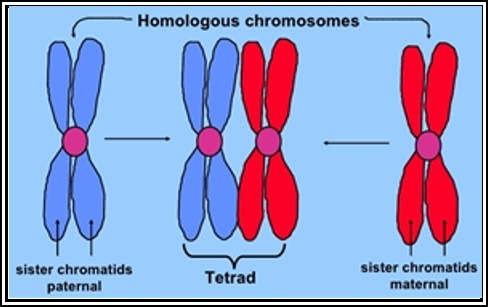What is the difference between a tetrad and a chromatid pair?
The bivalent combination of chromatids is described by the use of tetrad and chromatid terms. Bivalent refers to a pair of homologous chromosomes during meiosis.
The main difference between a chromatid pair and a tetrad is that a chromatid pair entails two sister chromatids of a single chromosome after undergoing DNA replication whereas a tetrad entails four sister chromatids of the bivalent.

Comparison Table (Tetrad Vs Chromatid Pair)
| Basic Terms | Tetrad | Chromatid Pair |
| Definition | It consists of four sister chromatids formed during the prophase of meiosis | It consists of two sister chromatids after undergoing DNA replication |
| Occurrence | During the prophase of meiosis I after pairing homologous chromosomes | During the S phase of the cell cycle after undergoing DNA replication |
| Chromatids Number | Four sister chromatids of the bivalent | Two sister chromatids of a single chromosome of the bivalent |
| In the Bivalent | Include sister chromatids of both chromosomes of homologous pair | Include one chromosome of homologous pair |
| Origin | Sister chromatids originate from both maternal and paternal | The sister chromatids have either maternal or paternal origin |
| Homologous Recombination | Tend to undergo homologous recombination | Do not undergo homologous recombination |
| Holding Together | Chromatids tend to hold together by the formation of synaptonemal complexes | Chromatids are held together by cohesion proteins |
What Is a Tetrad?
It is formed during the prophase of meiosis and it consists of two homologous chromosomes. Each homologous chromosome has two sister chromatids.
These chromatids tend to undergo recombination through chromatid crossing over. It is the best process of producing a genetic variation in a successive generation.
What Is a Chromatid Pair?
It is two chromatids from a single chromosome after undergoing DNA replication. The DNA replication tend to occur during the S phase of interphase.
The process tends to help the cell prepare for the next cell division. The replicated chromosomes tend to condense during metaphase I of meiosis I.
The two sister chromatids are held together by cohesion proteins through the subsequent steps of cell division.
Main Difference between a Tetrad and a Chromatid Pair
- Sister chromatids of a tetrad are held together through the formation of synaptonemal complexes while those of a chromatid pair is held by cohesion proteins
- Tetrad tend to undergo recombination whereas chromatid pair do not undergo recombination
- Tetrad originate from both maternal and paternal while chromatid pair has either maternal or paternal origin
- Tetrad consists of sister chromatids of both chromosomes of homologous pair while chromatid pair consists of a single chromosome of homologous pair
- Tetrad has four sister chromatids of the bivalent while chromatid pair has two sister chromatids of a single chromosome of the bivalent
Read More: Difference between Single-Stranded DNA and Double-Stranded DNA
Similarities between a Tetrad and a Chromatid Pair
- Both involve a combination of sister chromatids of homologous chromosomes
- Both sister chromatids undergo DNA replication
- Both pair occur during the prophase of meiosis
Tetrad vs Chromatid Pair FAQs
Is A Tetrad A Homologous Chromosome Pair?
Yes. Tetrad has the same genes but different alleles. Besides that, they occur during the first prophase of meiosis.
How Do You Know If A Chromosome Is Homologous?
The chromosome should have the same length, centromere position, and staining patterns. That’s not all. Homologous chromosomes have the same genes.
Is A Sister Chromatid A Chromosome?
Yes. So long as the two sister chromatids are connected at the centromere. But if they have been pulled apart during cell division then they are different chromosomes.
Does Each Chromosome Have The Same DNA?
Different chromosomes contain different genes. That is, each chromosome contains a specific chunk of the genome.
How Many Chromosomes Are In A Tetrad?
Four chromosomes. The pairing of homologous chromosomes is the key to understanding meiosis. Crossing-over is when chromosomes overlap and exchange portions of their chromatids.
Comparison Video
Summary
Tetrad has four sister chromatids and chromatid pair has two sister chromatids on a single chromosome of the bivalent. Keep in mind that each chromosome has a different genetic content.
More Sources and References
- Bivalent (Genetics). Wikipedia
- Meiosis I. Lumen Learning Course